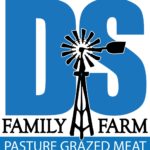Worried about what you are "really" eating? Have peace of mind with pasture grazed meats.
Omega 6:3 (2020 Results)
We now have 5 years of laboratory data from testing our pasture grazed beef. Since the label of “Grassfed” is meaningless, at DS Family Farm we go the extra steps to ensure customers that our beef is truly grassfed from birth to harvest:
- Third-Party Certification by A Greener World (Certified Grassfed by AGW).
- Annual Fatty Acid Profile testing of beef by Midwest Labs, Omaha Nebraska.
- DS Family Farm beef born and raised in U.S.A – Nebraska.
Why is the label “grassfed” meaningless?
With awareness of how food impacts our health, the demand for real, nutritious whole food, such as grassfed meats has increased dramatically over the past two decades. The term “grassfed” is just another marketing strategy being used by the large-scale meat industry. Along with terms like “natural” and “free-range”, “grassfed” is a way to trick consumers into buying a product with less than accurate advertising. True, almost all beef are “grassfed” for a portion of their lives but that is not the “rest of the story”.
As an informed consumer of “grassfed” products, you need to know how the animal was raised from birth to harvest. Not only that, but you also need to know where the animal was raised! Currently, about 80 percent of “grassfed” beef found in grocery stores came from outside of the USA. This includes grocery store “grassfed” beef from other countries with the label “Product of USA”! This is a loophole in our labeling laws since Congress eliminated country of origin labeling in 2015. (Information from recent “The Regeneration” newsletter.)
Why analyze Omega 6 to Omega 3 ratio?
Unlike carbohydrates, certain fatty acids are “essential nutrients” we must consume in our diets. We have discussed the need for both O6 and O3 fatty acids in past posts. The current Standard American Diet (SAD) includes high levels of omega-6 seed/vegetable oils resulting in a SAD intake O6:O3 ratio around 15:1. “Several sources of information suggest that human beings evolved on a diet with a ratio of omega-6 to omega-3 essential fatty acids of approximately 1:1.” (PubMed Source)
Past studies have found that true pasture raised beef results in meat testing with a low O6:O3 ratio. Beef are ruminants and are designed to eat forages. When they live their entire lives on forages, as designed, their resulting meat fits a low O6:O3 profile. (Beef Tallow Study, Rib Eye Study)
Know your farmer know your food!
This study from 2019 confirms that grocery store beef labeled “Grass-Finished” will not consistently exhibit a low O6:O3 profile. The study only includes 12 producers. Some producers noted they used grain by-products for supplementation even though they labeled their product as “Grass-Finished”. The five producers with the lowest O6:O3 ratio reported their finishing diets were pasture-based. My guess, these producers harvest from green growing forages.
Though the Rib Eye study from Mother Earth News included 23 pasture-based farms. We do not know how many samples were in the beef only analysis (included beef, eggs, poultry and butter). These farms advertise as being pasture farms, and the resulting O6:O3 analysis holds true with a low O6:O3 analysis at 2:1.
Impact on your health.
As we have previously said, we are all biochemically unique. A similar diet consumed by different individuals will have different results. With that said, many of us could benefit from consuming “true grassfed beef” that exhibits a low O6:O3 fatty acid profile.
As noted by Diana Rodgers, RD, and Robb Wolf in the book SACRED COW, The Case For (Better) Meat: “swapping out 690 grams per week (about 24 oz) of red meat from conventional cattle for red meat from grass-fed cattle and lamb has been shown to significantly increase serum concentrations of total omega-3 fatty acids, including DHA, and reduce the ratio of serum omega-6 to omega-3 (2011 study). Daily intake of DHA was shown to increase by 4.5 milligrams from 9.5 to 14 milligrams, which is in line with values of DHA found in grass-fed beef. (2019 study)”
Diana and Robb go on to note that (1) you need to make sure the beef exhibits the low O6:O3 profile (know your farmer know your food) and (2) the 2011 study did not include individuals who include oily fish more than twice a month in their diet.
Should you try true grassfed beef to improve your blood serum O6:O3 fatty acid profile? Maybe you should start with testing. Then we recommend that you cut all vegetable/seed oils and watch the seed/nuts in your diet (all sources of omega-6 fatty acids).
Doug’s personal notes:
- O6:O3 blood serum is definitely below the average for people eating the standard American diet
- I do on occasion have a can of sardines, but I much prefer Sardines Of The Plains.
- I am biochemically unique.





